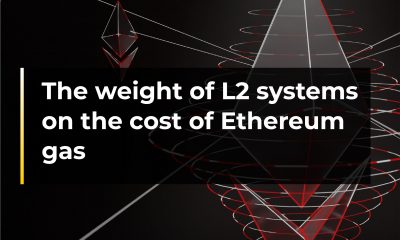FEATURED
Why Rollups present a unique business model in crypto: Insights from Galaxy Ventures Exec

Recently, at Mainnet 2023, an event organized by Messari, the general partner at Galaxy Ventures, Will Nuelle made a compelling case for rollups, positioning them as the optimal business model in the crypto space. Will also talks about the dynamics of block space, emphasizing its significance in the crypto landscape.
Rollups are Layer 2 scaling solutions for blockchains like Ethereum. They process transactions off-chain and bundle them into a single transaction on the main blockchain. There are two types: Optimistic Rollups and Zero-Knowledge (ZK) Rollups. Optimistic rollups allow anyone to execute transactions, while ZK rollups offer higher scalability, lower fees, and increased privacy.
Both types reduce congestion and computation load on the main blockchain, increasing transaction throughput and reducing costs. However, security, decentralization, and network control remain challenges. Optimistic rollups are compatible with Ethereum’s EVM and Solidity programming languages, making it easier for developers to port smart contracts and build dApps.
Galaxy Ventures is an investment firm focused on funding and supporting projects in Web3, DeFi, and cryptocurrency. They work with industry experts and a diverse team of crypto investors to provide innovative investment solutions for private equity investors, high-net-worth individuals, and hedge funds.
Their investments span protocols, scaling solutions, DeFi, and web3 infrastructure, with a focus on tech, biotech, media & entertainment, blockchain, consumer packaged goods, cannabis, and global eCommerce.
Historical business models
Drawing parallels with historical business model innovations, Will referred to Insight Partners’ strategic move in 1995, capitalizing on the growing PC market. He emphasized that new technologies often pave the way for innovative business models. In the current crypto landscape, rollups are emerging as a frontrunner.
Looking at this today, the existence of new technologies presents enormous opportunities to build and thrive in new businesses. In the crypto space, there are four successful basic business models, as noted by Will.
The first model is software business models, exemplified by companies like Fireblocks and Chainalysis. In this model, users pay for access to cutting-edge software solutions, creating a lucrative revenue stream. These businesses play a crucial role in enhancing the overall functionality, security, and efficiency of crypto operations.
The second is the exchange business. Cryptocurrency exchanges are leading the industry’s financialization trend. The inherent potential for crypto to be financialized presents exchanges with a robust and exciting business model. With a constant flow of trades and innovative features, exchanges have become key players in the crypto landscape.
The third is stablecoins. With a market cap exceeding $115 billion, stablecoins represent a thriving sector with a 4% net interest margin. This business model has proven remarkably successful, providing a stable and reliable digital representation of fiat currencies. The widespread adoption of stablecoins for various crypto transactions highlights their high product-market fit.
Lastly, there is block space, a sector often overlooked but gaining traction. This business involves selling block space to consumers on a per-operation basis. Its focus is on providing reliable and efficient block space for blockchain transactions. While less understood than other sectors, it has demonstrated solid product-market fit and holds significant potential for further growth.
Decoding block space in Ethereum: understanding payments and disparities
In the complex realm of blockchain technology, particularly in Ethereum, an important concept called “block space” takes center stage. Block space refers to the computational capacity generated by Ethereum every 12 seconds, enabling users to execute programs within its decentralized environment. This computational capacity is essentially auctioned off to consumers, granting them the right to utilize this virtual space for various operations.
Now, a question arises: What exactly are users paying for when they interact with this block space? Contrary to intuition, it’s not just applications or developers who shoulder the cost of this resource. Instead, it is the fundamental base-level user who bears the financial burden for the ability to carry out transactions and smart contracts within the Ethereum network.
He further highlighted that Ethereum distinguishes itself in the field by showcasing a strong market for its block space. On average, users of Ethereum are willing to pay an astounding $10 million per day to access this valuable resource. This payment accurately reflects the demand and value that users place on the computational capacity provided by Ethereum.
In contrast, alternative platforms like Arbitrum, Optimism, and BNB Chain demonstrate a notable disparity in user payments for block space. Collectively, users on these platforms pay approximately $100,000 per day for the same computational capacity that Ethereum users value at $10 million.
The Rise of Rollups
He dove deeper into the revenue trends of block space, unveiling that Ethereum currently dominates the market at 88-90%. However, Will highlighted an intriguing shift expected in 2022 and 2023, as alternative Layer 1 (L1) solutions are projected to experience significant growth, indicating a market rotation.
Examining the cost dynamics, he presented an income statement for Ethereum, revealing a gross margin of approximately 34%. In a comparative analysis, he explored Layer 2 (L2) rollups such as Arbitrum, showcasing their potential with a 25% gross profit over the past nine months.
Rollups, often compared to highly efficient workers in the digital realm, are expected to introduce a new era of cost efficiency. This innovation aims to reduce the substantial cost of call data, with Will projecting a remarkable 2–5-fold improvement in cost-effectiveness over the next year.
The noteworthy aspect of this development lies in its direct impact on profit margins. Businesses that adopt Layer 2 solutions (L2s), such as platforms like Arbitrum, can expect a significant boost in their gross margins. Projections suggest an impressive surge from the current 25% to as high as 70% or even 80%.
Furthermore, it is worth highlighting that Layer 2 technology is presently undervalued, presenting an exceptional and compelling investment opportunity. The potential for Layer 2 to reshape profit structures is being hailed as one of the most mispriced and intriguing business models in today’s dynamic market.
Read also; Solana exec explains layer 1’s plan to transform stablecoins






















